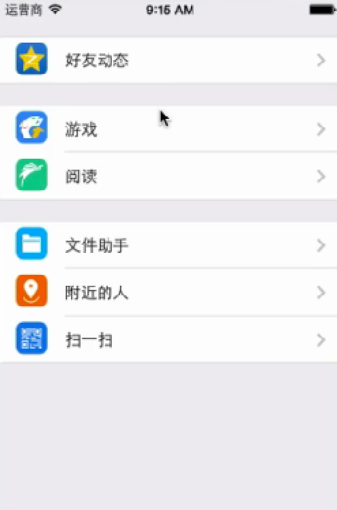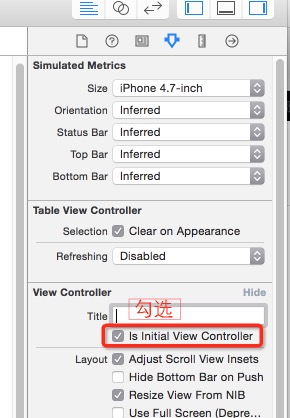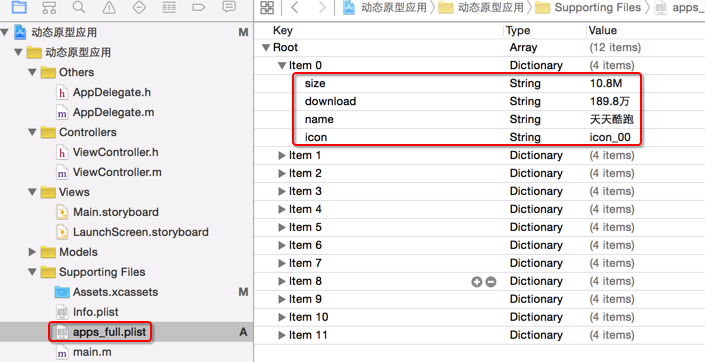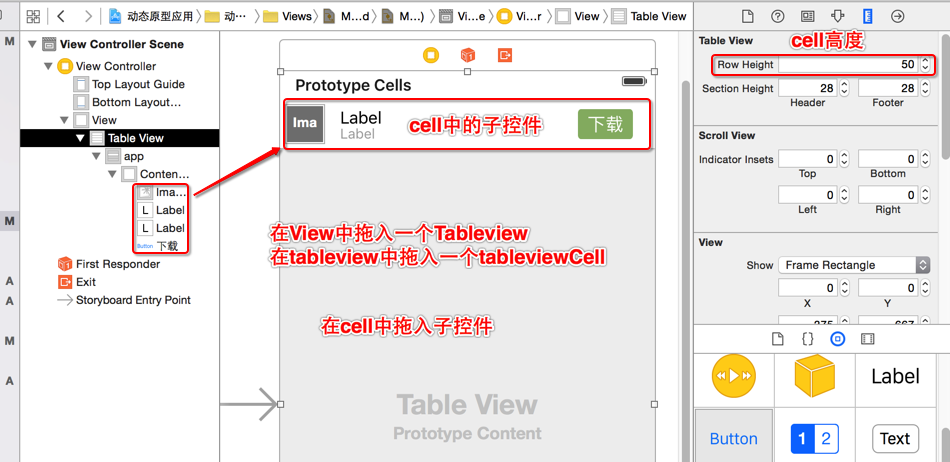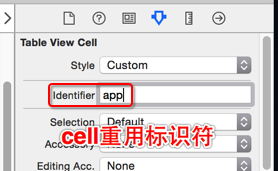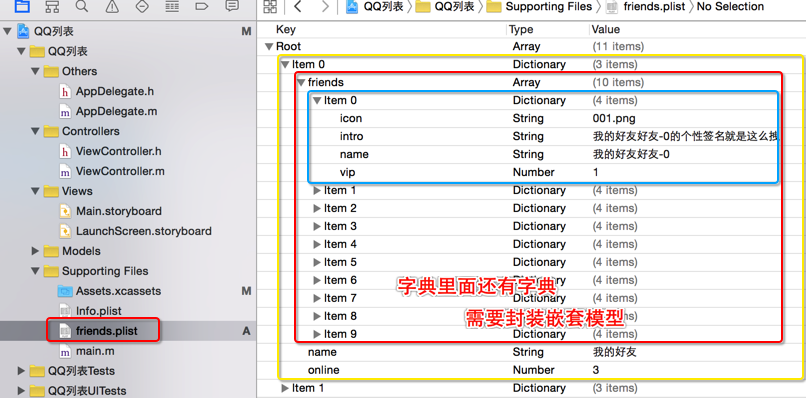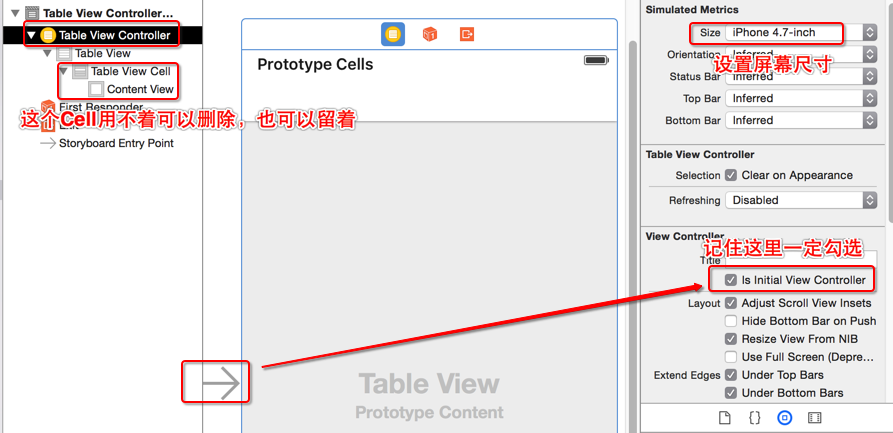学习目标
1.【掌握】静态单元格应用
2.【掌握】动态原型应用
3.【理解】UITableViewHeaderFooterView
一、静态单元格应用
这个案例的目的是了解静态单元格的使用场合及操作方式,在一些情况下使用静态单元格会更加方便和快捷。我们需要了解静态单元格的一些特性及设置方式。案例效果图如下:
静态单元格只支持UITableViewController,所以先将之前的viewController删除。拖入UITableViewController,设置Size属性。再选择UITableView并设置属性Content属性为Static Cells:
Dynamin ProtoTypes:动态单元格,通过代码进行设置
Static Cells:静态单元格,通过界面进行设置,固定的。
设置每一组cell的数量:默认每一组有三个cell,修改每一组cell的数量。
设置cell的高度:Cell的高度也就是tableview的row height属性。
设置cell的显示样式:这里的样式和代码创建cell的系统提供的样式类似,不过多了一个Custom自定义。
设置cell的图片:给Cell设置图片,也就是Cell的image属性赋值。
设置cell的文本:
完成上面的操作后我们可以添加任意组(sections),设置对应组的行数(rows)。
需要注意的是,当我们删除原有控制器,创建新控制器后需要将新控制器设为初始显示的控制器。也就是勾选Is Initial View Controller,否则启动模拟器看不到界面。如下图所示:
二、动态原型应用
上面演示了静态单元格的使用,下面接着演示动态原型的使用,也就是UITableView的Content属性中的Dynamic protoTypes。设置这个属性后,我们可以通过代码根据原型动态创建Cell。下面来看看一个应用管理的案例,案例效果图如下:
首先,创建项目,导入素材图片和plist文件。
创建模型类,加载plist文件中的数据封装模型,并返回模型数组。
JFApp.h
#import <Foundation/Foundation.h> @interface JFApp : NSObject @property (copy, nonatomic) NSString *size; @property (copy, nonatomic) NSString *download; @property (copy, nonatomic) NSString *name; @property (copy, nonatomic) NSString *icon; //快速创建模型 - (instancetype)initWithDictionary:(NSDictionary *)dict; + (instancetype)appWithDictionary:(NSDictionary *)dict; //返回模型数组 + (NSArray *)apps; @end
JFApp.m
#import "JFApp.h"
@implementation JFApp
//快速创建模型
- (instancetype)initWithDictionary:(NSDictionary *)dict {
if (self = [super init]) {
[self setValuesForKeysWithDictionary:dict];
}
return self;
}
+ (instancetype)appWithDictionary:(NSDictionary *)dict {
return [[self alloc] initWithDictionary:dict];
}
//返回模型数组
+ (NSArray *)apps {
NSArray *array = [NSArray arrayWithContentsOfFile:[[NSBundle mainBundle] pathForResource:@"apps_full.plist" ofType:nil]];
NSMutableArray *arrayM = [NSMutableArray array];
for (NSDictionary *dict in array) {
JFApp *app = [JFApp appWithDictionary:dict];
[arrayM addObject:app];
}
return arrayM;
}
@end
在Main.storyboard中修改size为4.7,拖入一个全屏的UITableView控件,再拖入一个UITableViewCell控件到UITableView中,并拖入Cell的子控件。Cell的高度也就是tableview的rowheight属性,tableview的content属性默认就是Dynamic prototypes(动态原型),所以无需更改。
创建Cell封装类,并指定Cell的Class属性为我们创建的封装类JFAppCell。
 指定Class后即可进行属性连线,一般属性连线我们都封装在类扩展(匿名分类,也叫延展)里,而不是.h文件中。
指定Class后即可进行属性连线,一般属性连线我们都封装在类扩展(匿名分类,也叫延展)里,而不是.h文件中。
 设置Cell的重用标识符(Identifier),并在类中定义一个模型属性和快速创建Cell的方法并实现。点击下载按钮后,会弹出一个提示,弹出的提示不会跟随tableview滚动,所以需要添加这个提示View到tableview的父视图中。这样就必须访问控制器,所以我们使用代理来完成这个操作,让控制器成为代理对象,替Cell完成点击事件。
设置Cell的重用标识符(Identifier),并在类中定义一个模型属性和快速创建Cell的方法并实现。点击下载按钮后,会弹出一个提示,弹出的提示不会跟随tableview滚动,所以需要添加这个提示View到tableview的父视图中。这样就必须访问控制器,所以我们使用代理来完成这个操作,让控制器成为代理对象,替Cell完成点击事件。
JFAppCell.h
#import <UIKit/UIKit.h> @class JFApp; @class JFAppCell; //定义一个代理 @protocol JFAppCellDelegate <NSObject> @required - (void)downloadButtonDidClick:(JFAppCell *)appCell; @end @interface JFAppCell : UITableViewCell //为子控件赋值的模型属性 @property (strong, nonatomic) JFApp *app; //代理属性 @property (weak, nonatomic) id<JFAppCellDelegate> delegate; //快速创建cell的方法 + (instancetype)appCellWithDictionary:(UITableView *)tableView; @end
JFAppCell.m
#import "JFAppCell.h"
#import "JFApp.h"
@interface JFAppCell ()
@property (weak, nonatomic) IBOutlet UIImageView *iconView;
@property (weak, nonatomic) IBOutlet UILabel *nameView;
@property (weak, nonatomic) IBOutlet UILabel *messageView;
@property (weak, nonatomic) IBOutlet UIButton *downloadView;
//下载按钮的点击事件
- (IBAction)downloadButtonDidClick;
@end
@implementation JFAppCell
//下载按钮的点击事件
- (IBAction)downloadButtonDidClick {
//点击下载按钮后禁用下载按钮
self.downloadView.enabled = NO;
//弹出下载信息,弹出View是添加View到Tableview的父容器中,这里无法访问到。所以得用代理
if ([self.delegate respondsToSelector:@selector(downloadButtonDidClick:)]) {
[self.delegate downloadButtonDidClick:self];
}
}
//快速创建cell的方法
+ (instancetype)appCellWithDictionary:(UITableView *)tableView {
//用cell重用标识符创建cell,这一步前必须在Cell中设置他的Identifier属性
JFAppCell *cell = [tableView dequeueReusableCellWithIdentifier:@"app"];
return cell;
}
//重写set方法为Cell的子控件赋值
- (void)setApp:(JFApp *)app {
_app = app;
//图标
self.iconView.image = [UIImage imageNamed:app.icon];
//名称
self.nameView.text = app.name;
//下载信息
self.messageView.text = [NSString stringWithFormat:@"大小:%@M | 下载量:%@万",app.size,app.download];
}
@end
在控制器对tableview进行控件连线,然后懒加载模型数组,并实现数据源方法和Cell的代理方法。最终实现我们的需求,具体控制器中的代码如下:
ViewController.m
#import "ViewController.h"
#import "JFApp.h"
#import "JFAppCell.h"
@interface ViewController () <UITableViewDataSource,JFAppCellDelegate>
@property (weak, nonatomic) IBOutlet UITableView *tableView;
@property (strong, nonatomic) NSArray *apps;
@end
@implementation ViewController
//隐藏顶部状态栏
- (BOOL)prefersStatusBarHidden {
return YES;
}
- (void)viewDidLoad {
[super viewDidLoad];
self.tableView.dataSource = self;
}
//懒加载
- (NSArray *)apps {
if (_apps == nil) {
_apps = [JFApp apps];
}
return _apps;
}
//每组一共有多少行数据
- (NSInteger)tableView:(UITableView *)tableView numberOfRowsInSection:(NSInteger)section {
return self.apps.count;
}
//创建cell
- (UITableViewCell *)tableView:(UITableView *)tableView cellForRowAtIndexPath:(NSIndexPath *)indexPath {
//获取当前数据模型
JFApp *app = self.apps[indexPath.row];
//创建cell
JFAppCell *cell = [JFAppCell appCellWithDictionary:tableView];
//指定Cell的代理对象
cell.delegate = self;
//为Cell赋值
cell.app = app;
return cell;
}
//实现Cell的代理方法,在下载按钮被点击后触发
- (void)downloadButtonDidClick:(JFAppCell *)appCell {
//创建提示Label
UILabel *downMessage = [[UILabel alloc] init];
//计算并设置frame
CGFloat downW = 200;
CGFloat downH = 20;
CGFloat downX = (self.view.frame.size.width - downW) / 2;
CGFloat downY = (self.view.frame.size.height - downH) / 2;
downMessage.frame = CGRectMake(downX, downY, downW, downH);
//设置一些属性
downMessage.text = [NSString stringWithFormat:@"%@正在下载...",appCell.app.name];
downMessage.backgroundColor = [UIColor grayColor];
downMessage.textAlignment = NSTextAlignmentCenter;
downMessage.alpha = 0;
//添加到self.view中
[self.view addSubview:downMessage];
//以动画形式弹出提示并隐藏,最终移除
[UIView animateWithDuration:1 animations:^{
downMessage.alpha = 0.7;
} completion:^(BOOL finished) {
dispatch_after(dispatch_time(DISPATCH_TIME_NOW, (int64_t)(1 * NSEC_PER_SEC)), dispatch_get_main_queue(), ^{
[UIView animateWithDuration:1 animations:^{
downMessage.alpha = 0;
} completion:^(BOOL finished) {
[downMessage removeFromSuperview];
}];
});
}];
}
@end
三、UITableViewHeaderFooterView
UITableViewHeaderFooterView是一个定义列表头部视图、列表尾部视图的类,HeaderFooterView一般是用在列表的头部,显示不同的分组状态信息。我们通过QQ分组来演示自定义HeaderFooterView的方法,下面是完成后的效果图:
导入素材和plist文件,从下图可以看出,我们需要创建嵌套模型,也就是每一个组好友和每一个好友都需要封装模型。
先封装单个好友模型,是否是vip定义为BOOL类型。
JFFriend.h
#import <Foundation/Foundation.h> @interface JFFriend : NSObject @property (copy, nonatomic) NSString *icon; @property (copy, nonatomic) NSString *intro; @property (copy, nonatomic) NSString *name; @property (assign, nonatomic, getter=isVip) BOOL vip; //快速创建模型数组 - (instancetype)initWithDictionary:(NSDictionary *)dict; + (instancetype)friendWithDictionary:(NSDictionary *)dict; @end
JFFriend.m
#import "JFFriend.h"
@implementation JFFriend
//快速创建模型数组
- (instancetype)initWithDictionary:(NSDictionary *)dict {
if (self = [super init]) {
[self setValuesForKeysWithDictionary:dict];
}
return self;
}
+ (instancetype)friendWithDictionary:(NSDictionary *)dict {
return [[self alloc] initWithDictionary:dict];
}
@end
然后再封装一组好友的模型,因为好友分组是有收起、展开两种状态的,所以定义一个BOOL类型来存储好友组的状态。
JFFriendGroup.h
#import <Foundation/Foundation.h> @interface JFFriendGroup : NSObject @property (strong, nonatomic) NSArray *friends; @property (copy, nonatomic) NSString *name; @property (assign, nonatomic) int online; //是否陈列出好友列表,默认不陈列 @property (assign, nonatomic, getter=isDisplay) BOOL display; //快速创建组模型 - (instancetype)initWithDictionary:(NSDictionary *)dict; + (instancetype)friendGroupWithDictionary:(NSDictionary *)dict; //返回组模型数组 + (NSArray *)friendGroups; @end
JFFriendGroup.m
#import "JFFriendGroup.h"
#import "JFFriend.h"
@implementation JFFriendGroup
//快速创建组模型
- (instancetype)initWithDictionary:(NSDictionary *)dict {
if (self = [super init]) {
[self setValuesForKeysWithDictionary:dict];
//这样赋值后friends数组中是字典,需要转模型
NSMutableArray *arrayM_temp = [NSMutableArray array];
for (NSDictionary *dict_temp in self.friends) {
JFFriend *myFriend = [JFFriend friendWithDictionary:dict_temp];
[arrayM_temp addObject:myFriend];
}
self.friends = arrayM_temp;
}
return self;
}
+ (instancetype)friendGroupWithDictionary:(NSDictionary *)dict {
return [[self alloc] initWithDictionary:dict];
}
//返回组模型数组
+ (NSArray *)friendGroups {
NSArray *array = [NSArray arrayWithContentsOfFile:[[NSBundle mainBundle] pathForResource:@"friends.plist" ofType:nil]];
NSMutableArray *arrayM = [NSMutableArray array];
for (NSDictionary *dict in array) {
JFFriendGroup *friendGroup = [JFFriendGroup friendGroupWithDictionary:dict];
[arrayM addObject:friendGroup];
}
return arrayM;
}
@end
封装Cell类,这里的Cell是指好友而不是分组。也就是每一个Cell显示一个好友的信息,所以我们定义的模型属性是好友模型而不是好友分组模型。并且这里使用系统提供的Cell样式已经能够满足我们的需求,所以无需再手动创建。具体Cell类代码入下:
JFFriendCell.h
#import <UIKit/UIKit.h> @class JFFriend; @interface JFFriendCell : UITableViewCell @property (strong, nonatomic) JFFriend *myFriend; //快速创建cell + (instancetype)friendCellWithTableView:(UITableView *)tableView; @end
JFFriendCell.m
#import "JFFriendCell.h"
#import "JFFriend.h"
@implementation JFFriendCell
//快速创建cell
+ (instancetype)friendCellWithTableView:(UITableView *)tableView {
static NSString *ID = @"myFriend";
//从缓存中创建Cell
JFFriendCell *cell = [tableView dequeueReusableCellWithIdentifier:ID];
if (cell == nil) {
//系统自带的样式已经能够满足我们的需求,所以无需手动创建,直接使用合适系统提供的cell样式
cell = [[JFFriendCell alloc] initWithStyle:UITableViewCellStyleSubtitle reuseIdentifier:ID];
}
return cell;
}
//重写set方法为Cell赋值
- (void)setMyFriend:(JFFriend *)myFriend {
_myFriend = myFriend;
//为Cell赋值
self.imageView.image = [UIImage imageNamed:myFriend.icon];
self.textLabel.text = myFriend.name;
self.detailTextLabel.text = myFriend.intro;
//如果是vip则昵称是红色
if (myFriend.isVip) {
self.textLabel.textColor = [UIColor redColor];
}
}
@end
封装好模型和Cell后我们就可以在控制器进行调用了,先显示出数据,再根据我们的需求进行修改。我们的QQ列表整个都是tableview,所以不用使用ViewController,直接使用TableviewController。在Main.storyboard中删除原有的ViewController拖入一个TableviewController。
然后再修改ViewController.h的继承父类为UITableViewController,才能设置新的控制器所属Class为这个类。
#import <UIKit/UIKit.h> //修改继承的父类为UITableViewController @interface ViewController : UITableViewController @end
设置UITableViewController的Class属性为ViewController,我们也可以新创建一个类继承自UITableViewController,然后在这里设置Class为我们新创建的那个类。
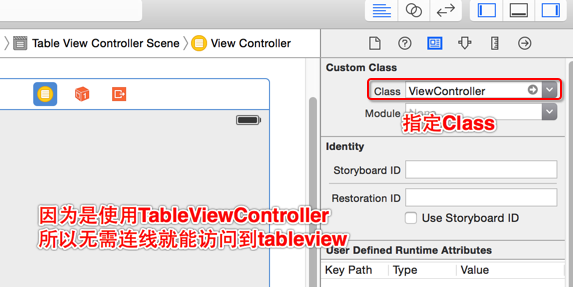 在控制器中懒加载数据,实现数据源方法显示出数据。因为我们Main.storyboard中使用的是TableViewController,所以无需手动遵守数据源、代理协议和手动指定数据源对象、代理对象。
在控制器中懒加载数据,实现数据源方法显示出数据。因为我们Main.storyboard中使用的是TableViewController,所以无需手动遵守数据源、代理协议和手动指定数据源对象、代理对象。
ViewController.m
#import "ViewController.h"
#import "JFFriendGroup.h"
#import "JFFriendCell.h"
#import "JFFriend.h"
@interface ViewController ()
@property (strong, nonatomic) NSArray *friendGroups;
@end
@implementation ViewController
//隐藏状态栏
- (BOOL)prefersStatusBarHidden {
return YES;
}
- (void)viewDidLoad {
[super viewDidLoad];
}
//懒加载
- (NSArray *)friendGroups {
if (_friendGroups == nil) {
_friendGroups = [JFFriendGroup friendGroups];
}
return _friendGroups;
}
//一共多少组,每一个小组就是一组
- (NSInteger)numberOfSectionsInTableView:(UITableView *)tableView {
return self.friendGroups.count;
}
//每组多少行
- (NSInteger)tableView:(UITableView *)tableView numberOfRowsInSection:(NSInteger)section {
//获取组模型
JFFriendGroup *friendGroup = self.friendGroups[section];
return friendGroup.friends.count;
}
//创建Cell
- (UITableViewCell *)tableView:(UITableView *)tableView cellForRowAtIndexPath:(NSIndexPath *)indexPath {
//获取组模型
JFFriendGroup *friendGroup = self.friendGroups[indexPath.section];
//获取单个好友模型
JFFriend *myFriend = friendGroup.friends[indexPath.row];
//创建cell
JFFriendCell *cell = [JFFriendCell friendCellWithTableView:tableView];
//为Cell赋值
cell.myFriend = myFriend;
return cell;
}
@end
完成后的效果为:
数据已经显示出来了,但是没有进行分组。如果我们使用系统自带的分组样式,是无法满足需求的。比如整个分组头部可以点击,并且带小图标,说明这整个分组头部是一个按钮,并且按钮上还有一个Label用来显示在线人数。
下面开始自定义ViewHeaderFooterView,创建一个类并继承自UITableViewHeaderFooterView类。headerView点击后会展开列表,也就是会刷新tableview,这个操作在headerView中是无法完成的(不能将控制器做参数传递)。所以我们通过代理来完成,让控制器成为headerView的代理对象,并实现对应的代理方法来完成这个需求。
JFHeaderView.h
#import <UIKit/UIKit.h> @class JFFriendGroup; @class JFHeaderView; @protocol JFHeaderViewDelegate <NSObject> - (void)headerViewButtonDidClick:(JFHeaderView *)headerView; @end @interface JFHeaderView : UITableViewHeaderFooterView //返回一个headerView + (instancetype)headerViewWithTableView:(UITableView *)tableView; @property (strong, nonatomic) JFFriendGroup *friendGroup; //headerView的代理属性 @property (weak, nonatomic) id<JFHeaderViewDelegate> delegate; @end
JFHeaderView.m
#import "JFHeaderView.h"
#import "JFFriendGroup.h"
@interface JFHeaderView ()
@property (weak, nonatomic) UIButton *btn;//headerView按钮
@property (weak, nonatomic) UILabel *lbl;//在线人数
@end
@implementation JFHeaderView
//返回一个headerView
+ (instancetype)headerViewWithTableView:(UITableView *)tableView {
static NSString *headerID = @"header";
JFHeaderView *headerView = [tableView dequeueReusableHeaderFooterViewWithIdentifier:headerID];
if (headerView == nil) {
headerView = [[JFHeaderView alloc] initWithReuseIdentifier:headerID];
}
return headerView;
}
//重写initWithReuseIdentifier:方法创建自定义headerView
- (instancetype)initWithReuseIdentifier:(NSString *)reuseIdentifier {
if (self = [super initWithReuseIdentifier:reuseIdentifier]) {
UIButton *btn = [[UIButton alloc] init];
[btn setBackgroundImage:[UIImage imageNamed:@"buddy_header_bg"] forState:UIControlStateNormal];
[btn setBackgroundImage:[UIImage imageNamed:@"buddy_header_bg_highlighted"] forState:UIControlStateHighlighted];
[btn setImage:[UIImage imageNamed:@"buddy_header_arrow"] forState:UIControlStateNormal];
btn.contentHorizontalAlignment = UIControlContentHorizontalAlignmentLeft;
btn.contentEdgeInsets = UIEdgeInsetsMake(0, 10, 0, 0);
btn.titleEdgeInsets = UIEdgeInsetsMake(0, 10, 0, 0);
[btn setTitleColor:[UIColor blackColor] forState:UIControlStateNormal];
btn.imageView.contentMode = UIViewContentModeCenter;
btn.imageView.clipsToBounds = NO;
//添加到headerView
[self addSubview:btn];
self.btn = btn;
[self.btn addTarget:self action:@selector(headerViewButtonDidClick) forControlEvents:UIControlEventTouchUpInside];
UILabel *lbl = [[UILabel alloc] init];
//文本右对齐
lbl.textAlignment = NSTextAlignmentRight;
[self addSubview:lbl];
self.lbl = lbl;
}
return self;
}
//按钮单击事件
- (void)headerViewButtonDidClick {
self.friendGroup.display = !self.friendGroup.isDisplay;
if ([self.delegate respondsToSelector:@selector(headerViewButtonDidClick:)]) {
[self.delegate headerViewButtonDidClick:self];
}
}
//当一个新的headerView已经添加到某个父控件中的时候调用这个方法
- (void)didMoveToSuperview {
if (self.friendGroup.isDisplay) {
self.btn.imageView.transform = CGAffineTransformMakeRotation(M_PI_2);
} else {
self.btn.imageView.transform = CGAffineTransformMakeRotation(0);
}
}
//重写set方法为headerView赋值
- (void)setFriendGroup:(JFFriendGroup *)friendGroup {
_friendGroup = friendGroup;
//设置组名
[self.btn setTitle:friendGroup.name forState:UIControlStateNormal];
//设置在线人数
self.lbl.text = [NSString stringWithFormat:@"%d / %lu",friendGroup.online,friendGroup.friends.count];
}
//当将这个控件真正添加到父控件的时候,会调用这个方法设置当前控件的所有子控件的frame
- (void)layoutSubviews {
[super layoutSubviews];
self.btn.frame = CGRectMake(0, 0, self.frame.size.width, self.frame.size.height);
self.lbl.frame = CGRectMake(300, 0, 60, 44);
}
@end
在控制器中遵守JFHeaderViewDelegate代理协议并实现代理方法,实现单组数据刷新。
ViewController.m
#import "ViewController.h"
#import "JFFriendGroup.h"
#import "JFFriendCell.h"
#import "JFFriend.h"
#import "JFHeaderView.h"
@interface ViewController () <JFHeaderViewDelegate>
@property (strong, nonatomic) NSArray *friendGroups;
@end
@implementation ViewController
//隐藏状态栏
- (BOOL)prefersStatusBarHidden {
return YES;
}
- (void)viewDidLoad {
[super viewDidLoad];
//设置headerView的高度
self.tableView.sectionHeaderHeight = 50;
}
//懒加载
- (NSArray *)friendGroups {
if (_friendGroups == nil) {
_friendGroups = [JFFriendGroup friendGroups];
}
return _friendGroups;
}
//一共多少组,每一个小组就是一组
- (NSInteger)numberOfSectionsInTableView:(UITableView *)tableView {
return self.friendGroups.count;
}
//每组多少行
- (NSInteger)tableView:(UITableView *)tableView numberOfRowsInSection:(NSInteger)section {
//获取组模型
JFFriendGroup *friendGroup = self.friendGroups[section];
//是否展开好友
if (friendGroup.isDisplay) {
return friendGroup.friends.count;
} else {
return 0;
}
}
//创建Cell
- (UITableViewCell *)tableView:(UITableView *)tableView cellForRowAtIndexPath:(NSIndexPath *)indexPath {
//获取组模型
JFFriendGroup *friendGroup = self.friendGroups[indexPath.section];
//获取单个好友模型
JFFriend *myFriend = friendGroup.friends[indexPath.row];
//创建cell
JFFriendCell *cell = [JFFriendCell friendCellWithTableView:tableView];
//为Cell赋值
cell.myFriend = myFriend;
return cell;
}
//创建headerView
- (UIView *)tableView:(UITableView *)tableView viewForHeaderInSection:(NSInteger)section {
JFFriendGroup *friendGroup = self.friendGroups[section];
JFHeaderView *headerView = [JFHeaderView headerViewWithTableView:tableView];
//存储组
headerView.tag = section;
//指定控制器为代理
headerView.delegate = self;
headerView.friendGroup = friendGroup;
return headerView;
}
//点击headerView按钮的时候触发
- (void)headerViewButtonDidClick:(JFHeaderView *)headerView {
NSIndexSet *indexSet = [NSIndexSet indexSetWithIndex:headerView.tag];
//刷新指定组
[self.tableView reloadSections:indexSet withRowAnimation:UITableViewRowAnimationFade];
}
关于重用:
UITableViewHeaderFooterView与UITableViewCell在滑动屏幕时都可以根据标志进行重用,而在不滑动而只进行reloadData等刷新数据操作时,两者有不同表现:UITableViewHeaderFooterView将不能根据标志重用(即系统不会将其放入缓冲区),会创建新的视图代替旧的。UITableViewCell能根据标志重用。所以在自定义UITableViewHeaderFooterView首尾视图时,要注意刷新数据时对视图的处理。
